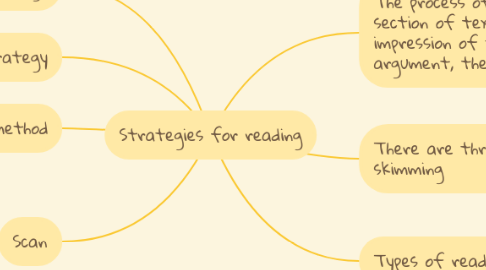
1. The RAP strategy
1.1. Read (a paragraph or a section).
1.2. Ask yourself some questions about what you just read.
1.3. Put the answers in your own words (and take notes if necessary).
2. The RIDA strategy
2.1. Read.
2.2. Imagine the scene you just read.
2.3. Describe it to yourself.
2.4. Add more details as you read.
3. The Five S method
3.1. Skim reading: Read the introduction, summary and the first and last sentences of each paragraph.
3.2. Scan: Where is the information about ...?
3.3. Select: Do you need to read the whole chapter?
3.4. Sip: Read selected sections in depth and more slowly.
3.5. Summarize: Use a map, key words, index cards, or questions as a framework for some notes.
4. Scan
4.1. Browsing an article
4.1.1. read the first and last paragraphs.
4.1.2. read the headings.
4.1.3. read maybe one or two sentences of each heading.
4.1.4. glance at the rest of each paragraph.
4.1.5. look at the graphs and illustrations.
4.2. Read an in-depth article
4.2.1. Once you have a good overview of the article, you should read it in depth and take careful notes, including complete reference information, if you are reading a PDF, you can use PDF annotation software to add notes directly to the file.
4.3. Scanning a book
4.3.1. Check the book's table of contents, table of figures, etc.
4.3.2. Read the chapter headings in the table of contents. If you find the key word or concept, go to the chapter, read the introduction and first paragraphs.
4.3.3. Search the table of contents for topics or keywords. If you find the keyword or concept in the table of contents, go to the appropriate page(s) in the book.
4.3.4. Look on the page(s) to find the concept, and then read the paragraphs above and below the one containing the keyword or concept.
4.4. Leafing through a book
4.4.1. Check the title and author.
4.4.2. Read the preface and the cover report about the author.
4.4.3. Check the contents. Look at the table of contents and examine the chapter headings. Look for a summary.
4.4.4. Pay close attention to the way paragraphs are organized and note their length. Long paragraphs may be elaborating a key thought, and short paragraphs link separate ideas.
5. The process of quickly viewing a section of text to get a general impression of the author's argument, themes, or main ideas.
5.1. Scanning
5.1.1. Used to quickly locate specific information: words, numbers, names, ideas or answers to specific study questions.
6. There are three types of skimming
6.1. Preview
6.1.1. Most of the time, followed by a second glance or in-depth reading, it is used to select a book, to examine a chapter before reading or studying it, to find the right material for research, to classify correspondence before answering it.
6.2. Overview
6.2.1. It is used to examine the reading material more thoroughly than in the preview, since you may not intend to read the material later.
6.3. Review above
6.3.1. The is to reacquaint oneself with the material that has been previously read or skimmed.
7. Types of reading
7.1. Reading of academic material
7.1.1. Words may be new or technical.
7.1.2. The sentence structure can be complex.
7.1.3. Some textbooks are definitely more user-friendly than others.
7.1.4. Headings, subheadings, and margin notes give useful clues to the author's meaning, but even so, some complex sentences must be carefully and deliberately deconstructed to make the interconnectedness of the message clear.
7.2. Reading a magazine article
7.2.1. Many articles have an abstract and a list of keywords at the beginning of the article, so read these sections to see if your keywords or concepts are in them.
